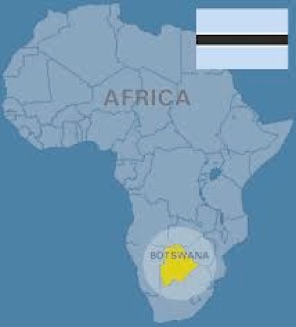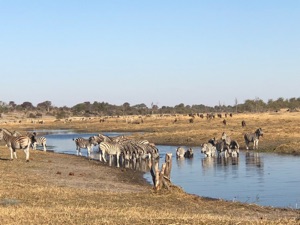Botswana and Victoria Falls 2018

The word safari originated from the word “safar”, an Arabic verb meaning “to make a journey.” From that come the noun “safariya,” or journey and then safari which is a Swahili synonym of the Arabic version. Whatever, we are going on one.
However, to get there from here is quite the journey: a van to Chicago, wait three hours, 7 hour flight to Amsterdam, 4 hour layover and an 11 hour flight to Johannesburg. Fortunately, the overnight hotel was on the airport property and we plopped into bed after checking in. Whoever said ‘It’s the journey, not the destination’ might have to try this.
July 29, 2018

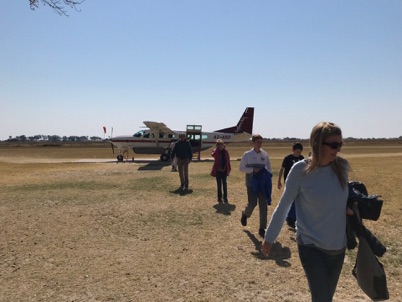
For the next eight days, we will be spending time at four different safari camps operated by Desert and Delta. They are the best in the area. Their website has some beautiful photographs of the properties.
a safari before our first game drive. With the absence of hunting, animals have acclimated to the fact that humans are not to be feared. In addition, the delta has an enormous wildlife population because of the tremendous supply of food and water.
Camp Xakanaka has 12 cabins built on platforms. Tonight, we are the only ones there. Each of the camps have a staff of thirty people. The service ratio is crazy. We will discover that all the camps have the most wonderful, caring, warm people anyone could ask for. Not just because it’s their job, it is just the way they are.
We will get accustomed to the pace of camp life for the next eight days and nights. Wake up is at 6:00, breakfast at 6:30, game drive at 7:00, lunch and siesta (relaxation time) at 11:30, high tea at 3:00, afternoon game drive at 3:30, sundowners and snacks out in the bush at 6:30, drinks and social time at 7:00, dinner at 7:30, lights out whenever.
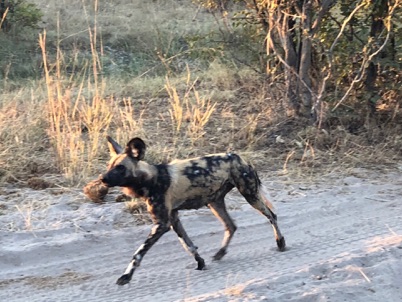
It cools off quickly in the late afternoon. We are here in their winter where rain is sparse and temperatures are more moderate than the rainy, humid, hot summers. Daytimes are in the low to mid 80’s; night times are in the 50’s.
The camp is surrounded by an electrified fence connected to wooden posts, but only at the top. It is there to keep out the elephants. Anything else can enter under the wiring or through the open gate. Every night for the last several weeks at least one hippo has come into camp. Last night, so did a waterbuck, a leopard and one of the guides thought he heard a hyena. Sleepwalking is discouraged. Matter of fact, when it is dark outside, it is required to have a guide walk you to your room. Beautiful evening with a star filled sky and full moon.
At 3:00 in the morning, we awakened to a hippo bellowing. It was so loud and clear, we thought it was on the front porch. We knew we were not in Kansas anymore.
July 30, 2018
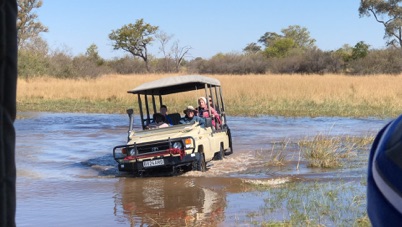
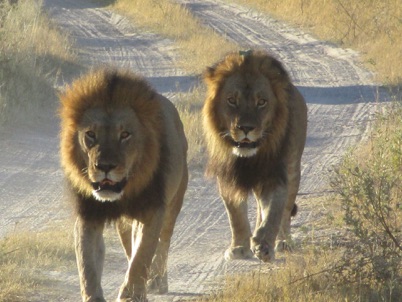
Harry said as big as these were, south of us in the Kalahari they are huge. The lack of water there along with the plentiful food supply is the reason why. For fluids, the blood of the prey is consumed and they grow inordinately large.
In short fashion, we were on the trail of a female leopard and her cub. The guides are incredible. From a footprint, not only can they tell the type of animal, but whether it is male or female, its size, the direction they are headed, how long ago it passed by (15 minutes, 2 hours or 4 days). Remarkable.
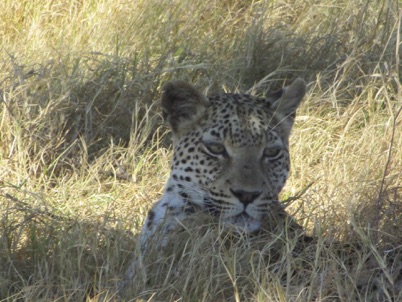
Botswana is a land-locked country bordered by Zimbabwe, Namibia, South Africa, and at the extreme northeastern tip, Zambia. The landscape is mostly flat. The size is about the same as France or Texas. Kalahari sands cover approximately 85% of the country and the Kalahari Desert itself dominates the south and west. The climate is sub-tropical and semi-arid.
Unlike neighboring countries, Botswana has never been under the direct rule of a colonial influence. However, in the 1880s, the country’s chiefs sought British protection to prevent the Boers incorporating the country into South Africa. The new protectorate was called Bechuanaland.
Complete independence was gained in 1966. At that time Botswana was the second poorest country in the world. Shortly thereafter, however, huge reserves of diamonds were discovered and along with tourism this country of 2 1/2 million is extremely stable.
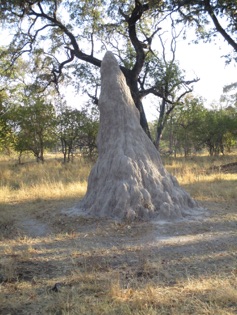
On our way back to camp we saw a hyena carrying the bloody carcass of a small impala. Tracks nearby suggested it was killed by a leopard and then stolen by the hyena. We tried to follow it but to no avail.
At camp, the boys taught TK, one of the staff, how to play some games we brought along. Linda taught TK how to play King’s Corners. Harrison, Riley and I played chess. As the nights went on the boys played a lot of monopoly. Bennett and I battled Fletcher and Sara in cribbage.
One of the nice traditions every night before dinner, part of the staff would gather and sing a couple of native songs.
July 31, 2018
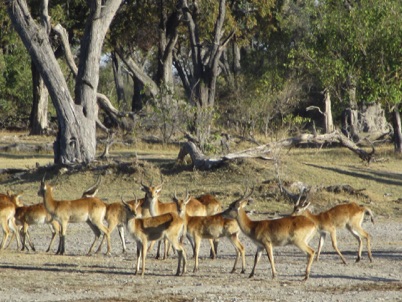
After touring a bit we arrived at the airport, not to check in or get a seat assignment but to clear the tiny airstrip of any animals lingering there or simply passing through.
Last night we had four hippos in camp. Two parked themselves in front of one of the cabin’s steps which quite rightly delayed one of the arriving guests.
We are going to miss Xakanaka. The rooms were delightful. The food wonderful...and best of all, the sweet people who made us welcome and treated us like family. In particular we will miss our guide Harry with his lilting Botswanan accent that pronounces zebra (zebra as in Debra) and hyenas (heinous). Quite charming.
A short flight and drive to Leroo La Tau (paw of the lion) Lodge. Gorgeous property, again with 12 rooms and a large, friendly staff. Leroo La Tau sits on a 15 meter high cliff overlooking the Boteti River. From our balconies we can enjoy the panoramic spectacle of elephants bathing while zebras and wildebeest drink and crocodiles watch.
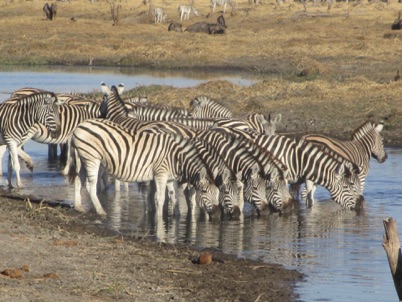
Crocodiles are scattered along the riverbanks. They kill by grabbing their victims and drowning them. Because they have no tongues, the preferred method is to store the kill, let it rot, and then consume. Essentially, they tear and swallow.
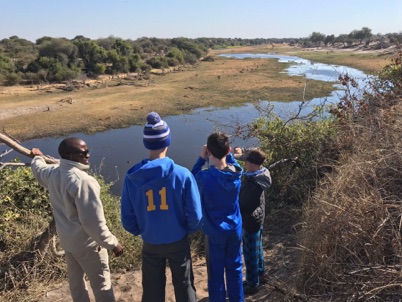
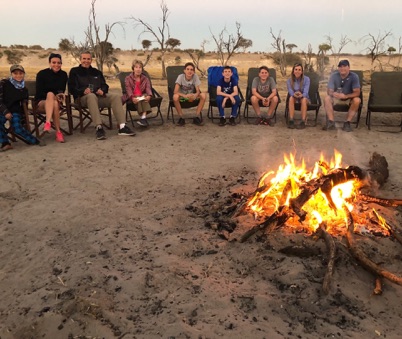
August 1, 2018
On our side of the river is a tribal reserve which includes a native village of about 1,000 people. Mostly they graze cattle on the arid land.
As we crossed the river into the National Park, our guide immediately found fresh sets of tracks for two cheetahs. We spent the next two hours looking for them to no avail. The area is so vast it is almost random luck to find the cagey cats. The hunt was exciting, however.

We stopped on the way back to lunch on a bluff overlooking the river and watched 20 hippos at play. Mark loves hippos and was in heaven as they snorted and bobbed around.
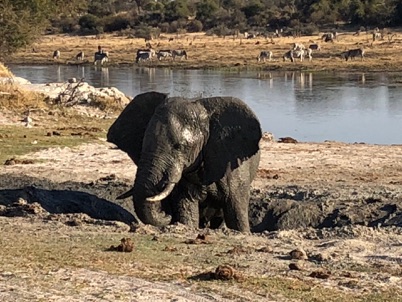
We crisscrossed the the park looking for two mother lions and their six cubs or the two cheetahs. Sadly, they did not want to be found. Maybe tomorrow morning before the plane to Camp Okavango.
August 2, 2018
On our morning drive we saw a number of jackals, kind of a good sized dog. We are looking for cats, but none to be seen. The valley was full of zebra, gazelles and wildebeests, however. It is a beautiful day again.
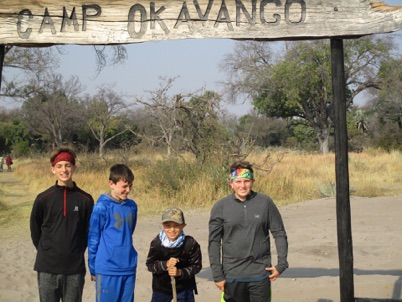
This morning an old bull elephant had come down to the river to drink and eat the soft plant growth along the banks. Elephants grow 6 sets of teeth over their lifetime. Once the last set falls out is is damaged, they have a difficult time surviving. Soft food and solitaire are what remains.
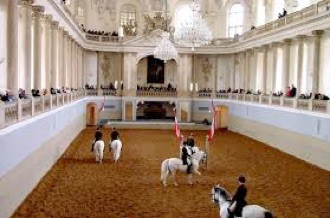
The camp is very rustic. Rather what one imagines when mentally bringing up images of Africa. Another beautiful sunset as we sipped beverages, our sundowners, floating on a pond in the Okavango Delta.
The delta is one of the world’s largest inland water systems, the only inland delta of its kind. It spans over 16,000 kilometers and supports a staggering variety of animal, plant, fish and birdlife.
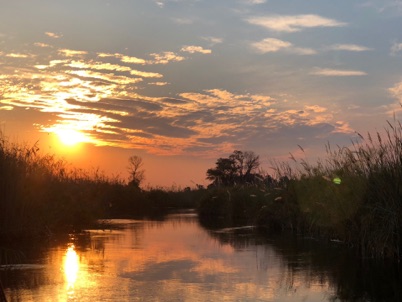
The Okavango Delta owes its existence to rainfall in the Angolan highlands. The rainy season begins in November and the floodwaters begin their long journey downstream. Because of the gentle slope of the Delta basin, the floods take arounds six months to make their way from Angola, hence the Delta reaches its peak size in the dry, winter months. It is a UNESCO Heritage site.
August 3, 2018
Our 15 minute morning boat ride took us to a larger delta island for a walking tour. We were a smidge concerned as to whether this was really a good idea. But we figured they can’t lose too many tourists or they will get a bad reputation.
After a short stroll we came upon a herd of cape buffalo. Thank goodness it was not a single animal. The guide said they are not dangerous if in a herd (easy for him to say), but if solitary, they will charge without warning, full out. Unlike lions and elephants who do fake charges, if one of these guys is after you, be prepared to kiss it goodbye. Still, when the herd is 35 yards away, it is a bit disconcerting.
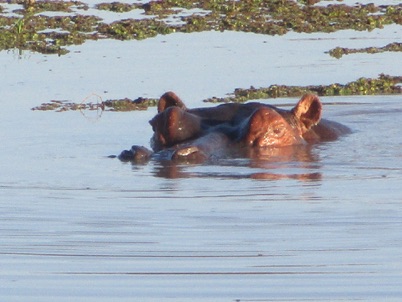
I always find it curious the trust we place with people we have never met and will probably never see again while on vacation.
On our way back to the boat, a huge warthog burst out of the brush 10-15 yards away from us. Great morning. On the bush walks, everyone walks single file so the group looks larger to animals as they view us. Good strategy, I guess. At least it worked today.
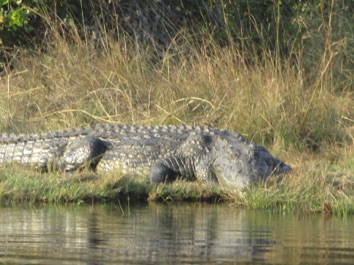

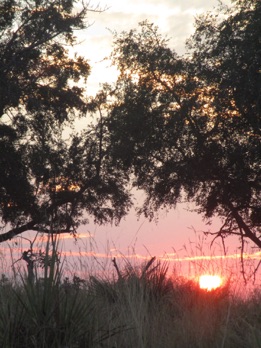
Returning, the staff had set up a picnic table with snacks and sundowners as we watched another magnificent sunset.
August 4, 2018
Today, we fly to our last camp, Savute, in Chobe National Park, home of a famous lion pride and the largest concentration of elephants (140,000) in the world. The flights have taken us over a great portion of this enchanting landscape, both desert and delta.
Some years ago, the government decided not to put blacktop roads into this area in order not to spoil the natural wonder of it. Visitors here number in the thousands each year unlike an accessible park like Yellowstone which attracts 3 million plus.
Our game drive this afternoon featured an area much more open than the previous ones we have visited. We passed a bathing elephant who came so close to our truck, we could have reached out and petted it.
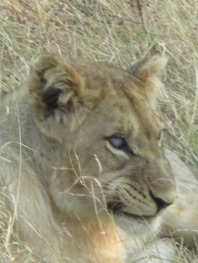
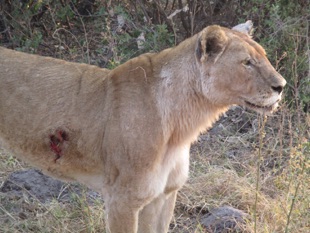
These animals are magnificent, whether alone or in a group. During mating season they are sexually active every 10-15 minutes around the clock for several days. Pretty impressive.
What a day. This evening we dined on a platform overlooking our camp’s waterhole. Several elephants appeared almost as apparitions. So quiet, we could hear them talking to each other...quite a magical place.
August 5, 2018
Overnight we heard lions roaring and elephants trumpeting. Our guide, Metal, said the poor sighted elephants probably blundered into a pride’s area and the disturbance was on. It was undoubtedly some distance from our camp, but it seemed close.
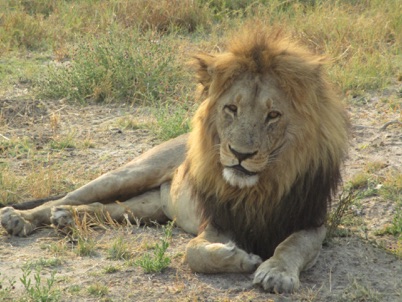

One youngster had the lower part of his trunk missing. Our guide guessed it had been bitten off by a croc. A two week old baby rolled over completely submerged and loved every minute of it. We were all mesmerized, particularly Lisa and Sara, who are elephant aficionados.
The lions we heard this morning were discovered fairly close by and we found four good sized males ages 4-5 lounging 2x2 under the trees. They are so beautiful to watch. Older ones live to be about 18 years so these were fairly young.
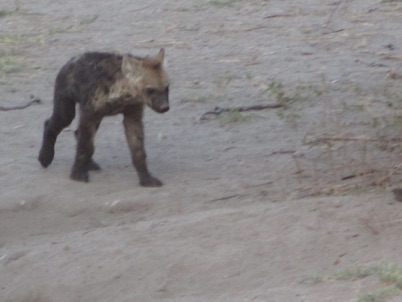
They grow to be about 70 pounds and scavenge primarily at night able to smell dead food 3 miles away.
After a dinner by candlelight watching elephants come to the camp waterhole, one of our guides walked us back to our room. The camp has had a regular leopard night visitor, so discretion was warranted.
Linda and I discussed whether we enjoyed Kenya 21 years ago or Botswana better. Kenya is more open with its Mara and Serengeti plains, sort of like the movie Out of Africa, but it is difficult to choose. Botswana is semi-arid and Kenya more temperate. Kind of like picking between Florida and Arizona.
August 6

Staff members, of course, are taught to be courteous, the warmth we encountered from everyone is just who they are. It really is like spending time with family far away from home.
Flying from Savute, we are reminded how natural this area remains. There are no concrete or blacktop roads for miles in every direction. The distance from here to Maun is about 100 miles. The “road” is all sand and travel time is 6+ hours
to the outskirts of the city, more if there is 4-legged traffic on the road.
We landed in Kesane near the border, cleared customs and entered Zimbabwe where we waited 2 1/2 hours to clear customs there. Almost a disaster as we had to pay for temporary visas in cash and scrambled to come up with $270 for the nine of us. No ATMs. Thank goodness Linda was talking to a guide from another group who said if we declared ourselves as a family the fee was $20 per person less.
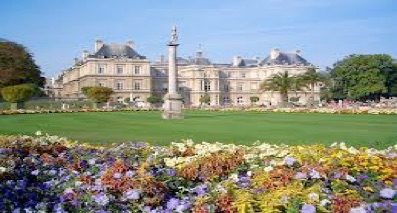
August 7, 2018
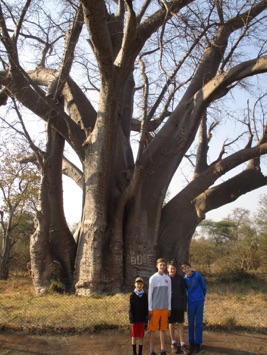
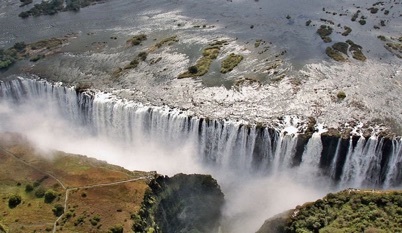
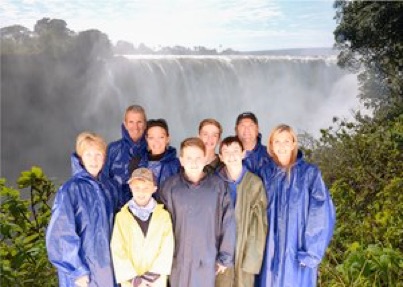

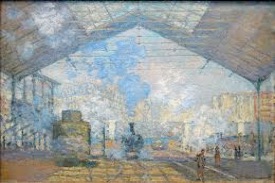
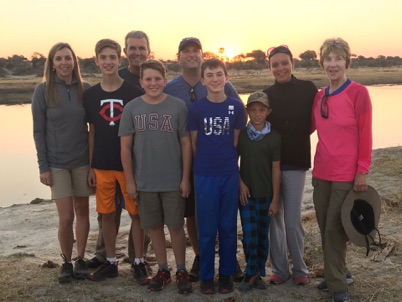
One last dinner and we pack for home.
August 8, 2018
From the time we were picked up at the lodge and delivered to the airport in Victoria Falls to the arrival back home measured 38 hours. Exhaustion with exhilaration thrown in.
What an adventure.
July 27, 2018
